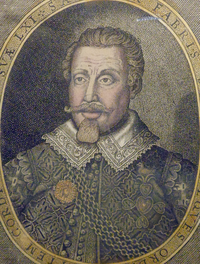|
|
You are not currently logged in. Are you accessing the unsecure (http) portal? Click here to switch to the secure portal. |
Wiktenauer:Main page/Featured
| Salvator Fabris | |
|---|---|
 | |
| Born | 1544 Padua, Italy |
| Died | 11 Nov 1618 (aged 74) Padua, Italy |
| Occupation |
|
| Nationality | Italian |
| Alma mater | University of Padua (?) |
| Patron |
|
| Influenced | |
| Genres | Fencing manual |
| Language | Italian |
| Notable work(s) | Scienza d’Arme (1601-06) |
| Manuscript(s) |
MS 17 (1600-20)
|
Salvator Fabris (Salvador Fabbri, Salvator Fabriz, Fabrice; 1544-1618) was a 16th – 17th century Italian knight and fencing master. He was born in or around Padua, Italy in 1544, and although little is known about his early years, he seems to have studied fencing from a young age and possibly attended the prestigious University of Padua. The French master Henry de Sainct Didier recounts a meeting with an Italian fencer named "Fabrice" during the course of preparing his treatise (completed in 1573) in which they debated fencing theory, potentially placing Fabris in France in the early 1570s. In the 1580s, Fabris corresponded with Christian Barnekow, a Danish nobleman with ties to the royal court as well as an alumnus of the university. It seems likely that Fabris traveled a great deal during the 1570s and 80s, spending time in France, Germany, Spain, and possibly other regions before returning to teach at his alma mater.
It is unclear if Fabris himself was of noble birth, but at some point he seems to have earned a knighthood. In fact, he is described in his treatise as Supremus Eques ("Supreme Knight") of the Order of the Seven Hearts. In Johann Joachim Hynitzsch's introduction to the 1676 edition, he identifies Fabris as a Colonel of the Order. It seems therefore that he was not only a knight of the Order of the Seven Hearts, but rose to a high rank and perhaps even overall leadership.
Fabris' whereabouts in the 1590s are uncertain, but there are rumors. In 1594, he may have been hired by King Sigismund of Poland to assassinate his uncle Karl, a Swedish duke and competitor for the Swedish crown. According to the story, Fabris participated in a sword dance (or possibly a dramatic play) with a sharp sword and was to slay Karl during the performance when the audience was distracted. (The duke was warned and avoided the event, saving his life.) In ca. 1599, Fabris may have been invited to England by noted playwright William Shakespeare to choreograph the fight scenes in his premier of Hamlet. He also presumably spent considerable time in the 1590s developing the fencing manual that would guarantee his lasting fame.
What is certain is that by 1598, Fabris had left his position at the University of Padua and was attached to the court of Johan Frederik, the young duke of Schleswig-Holstein-Gottorp. He continued in the duke's service until 1601, and as a parting gift prepared a lavishly-illustrated, three-volume manuscript of his treatise entitled Scientia e Prattica dell'Arme (GI.kgl.Saml.1868 4040).
In 1601, Fabris was hired as chief rapier instructor to the court of Christianus Ⅳ, King of Denmark and Duke Johan Frederik's cousin. He ultimately served in the royal court for five years; toward the end of his tenure and at the king's insistence, he published his opus under the title Sienza e Pratica d’Arme ("Science and Practice of Arms") or De lo Schermo, overo Scienza d’Arme ("On Defense, or the Science of Arms"). Christianus funded this first edition and placed his court artist, Jan van Halbeeck, at Fabris' disposal to illustrate it; it was ultimately published in Copenhagen on 25 September 1606.
Soon after the text was published, and perhaps feeling his 62 years, Fabris asked to be released from his six-year contract with the king so that he might return home. He traveled through northern Germany and was in Paris, France, in 1608. Ultimately, he received a position at the University of Padua and there passed his final years. He died of a fever on 11 November 1618 at the age of 74, and the town of Padua declared an official day of mourning in his honor. In 1676, the town of Padua erected a statue of the master in the Chiesa del Santo.
The importance of Fabris' work can hardly be overstated. Versions of his treatise were reprinted for over a hundred years, and translated into German at least four times as well as French and Latin. He is almost universally praised by later masters and fencing historians, and through the influence of his students and their students (most notably Hans Wilhelm Schöffer), he became the dominant figure in German fencing throughout the 17th century and into the 18th.
(Read more…)
- Recently Featured:
- Lew – Sigmund ain Ringeck – Andre Paurenfeyndt – Ridolfo Capo Ferro da Cagli – Antonio Manciolino
